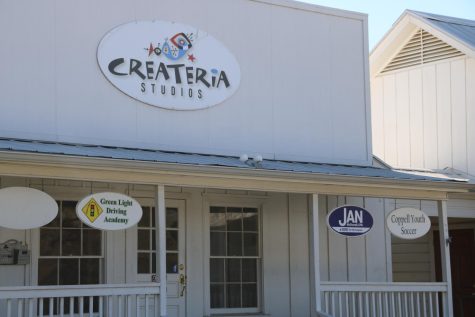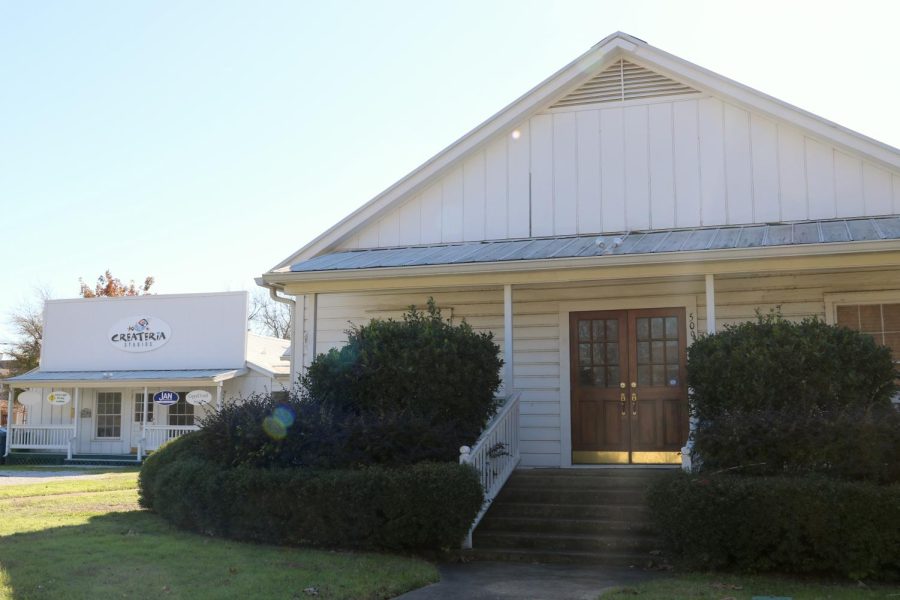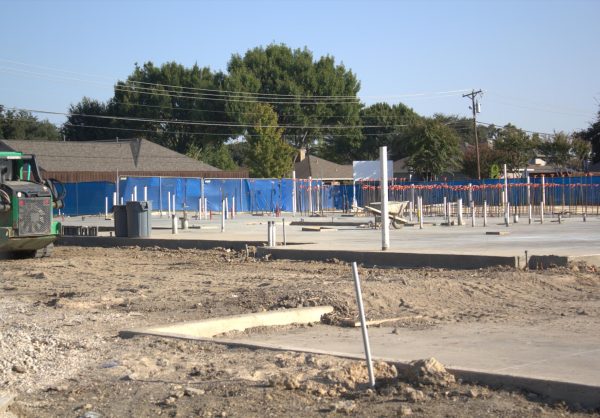Old Town Coppell church to remain at current location
Council votes to preserve two longtime structures
A proposal to relocate Coppell Baptist Church, the town’s first church built in 1948, along with its adjoining annex to make space for new multi-development complexes was considered at the Coppell City Council meeting on Tuesday. The council concluded that the church and annex will continue to reside in their current location.
Nestled on the corner of Main Street and W. Bethel Road reside two buildings. White paneling coats the exterior of the 1948-constructed Baptist church bordered by neatly trimmed grass, while Createria placards the neighboring 1953 Annex School House, formerly used as an art studio.
Not until recently had both Old Town Coppell edifices narrowly escaped the proposal of their redevelopment, leaving the plans of their destruction unscathed.
During Tuesday’s City Council meeting, a motion was made by Mayor Pro Tem Mathew Biju and seconded by council member John Jun to continue the public hearing, held specifically for the discussion regarding the redevelopment of the church, to the next meeting to allow parties to discuss and return with a solution. The motion was shut down by other members of the council.
Subsequent motions were then pushed to amend the original conditions of the development site plan, but each failed. Council members voted on the final motion to approve the zoning of item No. 10, the original plan for the zoning of the church (agreeing with the development plan by realtor Chris Collins), and the plan ultimately failed with council members Cliff Long, Don Carrol and Kevin Nevels for the motion and Brianna Hinojasa-Smith, Jun, Mathew and Mark Hill opposing it.
The community discourse surrounding the removal of the church began with Collins’s proposal to build seven lots containing six new buildings where the church and annex are currently located: five mixed-use buildings, one retail building and one parking lot.

In the mixed-use buildings, commercial and residential uses were to have separate entrances and separate occupancies. The buildings were proposed as a combination of office/residential, retail/residential and one full retail building. The residential proportion was to be located on the second floor and have two garage spaces on the ground level with access from the rear of the lot.
The city’s Planning & Zoning Commission recommended approval of the development plan (5-1) on Nov. 17, as long as 17 conditions were accepted. The 17th condition stated that “demolition or removal of the building shall require City Council consideration,” with the next City Council meeting occurring on Tuesday, giving community members the time to advance their opinions on the plan.
This development received backlash from community members, fearing that removing the church and annex would eliminate a historic location for the Coppell community. Rory Carrick, husband of Jacaranda Gift Shop owner Sarah Carrick in Old Town Coppell, organized a petition, signed by more than 1,500 individuals over the span of a month, against the development proposal.
To quell the fears of residents, Collins opened his office on Nov. 29 to discuss concerns regarding the possible development.
Collins cited one experience with a plumber in Coppell during his open office meeting times.
“He said ‘I was baptized in that church when I was 7 years old,’ and I said that’s amazing,” Collins said.“‘About the same time, you were baptized at that church, I was baptized at the First Baptist Church of Carrollton, Old Town Carrollton.’ We had a conversation and he goes ‘I just can’t believe you’re going to demolish the buildings.’ My immediate response was, ‘I’ve never said I’m demolishing the buildings.’ My intention has never been to demolish these buildings, ever.”
To keep the historic aspect of the church intact, Collins was a staunch proponent of either repurposing materials from the church to use on the porch of the new buildings or altogether relocating the church to Grapevine Springs Park next to the Coppell Senior and Community Center.
“There are ceiling fans, light fixtures, hardwood floors, cedar wainscoting around all the walls, old windows, the interior doors and trim,” Collins said. “Our concept of repurposing was to pull those materials out and repurpose them in the front porches that are required to be on these buildings, adding a commemorative plaque.”
This proposition was not enough: 10 individuals at the Dec. 13 city council meeting spoke opposing the development. At the same time, 10 individuals spoke in support of the development.
Among those who spoke for the development were Lucy and David Haase, a couple that moved into Coppell in July. Mrs. Haase’s arguments for the plan focused primarily on increasing traffic in Coppell through the addition of new buildings to create a less stagnant area.
“We came to the area looking for a home, we drove across the street and came across Old Town Coppell and instantly fell in love,” Mrs. Haase said. “We went into it and we drove around and we were like, ‘this is where we want to be.’ I didn’t know for the past 10 years that lot has been empty, I am pro seeing it developed. I want to see a little bit more movement, it does seem a little bit stagnant in that particular spot.”
Another idea in agreement with the development was that the church should not be considered historic.
“A church is the people, a congregation, it’s not the building; buildings come and go,” Coppell resident Barry Raven said. “I went around the building and looked in the windows. To me, it’s just a plain white building. There’s really no significant architecture as compared to other historical buildings. In this particular case, I think the plan going forward is better just to repurpose it.”
The church’s current partial owner, Steven Channick, also spoke in favor of the development.
“I took over after [my father’s] health deteriorated,” Channick said. “I’m intimate with the building, I know the structural problems that are there. I love the old building, but it’s functionally obsolete now. One reason we haven’t rehabbed that is because it’s just not worth the money to throw into that structure.”
Among those in opposition, the leading argument centered around the idea that adding the new buildings would take the “old” out of Old Town Coppell. Rather, the new structures would decrease foot traffic to already existing mom-and-pop shops and strip the historic aspects away from the community.
“I would like to share, as a shop owner in Old Town, the thing I hear over and over again from customers from all over is ‘Where is the rest of Old Town? We were hoping there was more this,’” Tattered Styles owner Dana Pugh said. “What they’re referencing is the charm and the feelings evoked by the historical buildings. A step back in time, a slowing down in the midst of the very stressed-out culture that we all now live in. One that simply cannot be replicated by new. By relocating or tearing down the church and annex, we are missing out on a real opportunity to enhance our community, to put Coppell on the map so to speak.”
Carrick, agreeing that the owner of the land had the right to sell his land, offered an alternative to the current development plan in which a group of residents will work to form a non-profit organization to acquire the land the church resides on. The annex will be altered to house eight to ten small retail shops, four office spaces, two large studios and two large shared spaces. The church would be repurposed as an event space where weddings, graduation parties and other events could be held.
“The goal will be to educate and inspire, to support small businesses’ growth and development into the size they choose to be,” Carrick said. “Our city has a vast pool of professionals that we’ll bring in to volunteer to help these small retailers learn their crafts. The annex would really compete with foot traffic, we’ve already got three tenants talking to us if this potentially becomes an option.”
Other Coppell residents, including Bethel Road Barber Shop owner Joe Shirley, furthered this plan.
Nonetheless, the final decision lay in the hands of the city council members, who called for an executive session and returned to public session only to continue going back and forth between their decisions. The final decision was made to keep the church as is and prohibit the development plans.
Even though alternatives were proposed during the public hearing, council members were to not take them under consideration given that the alternate plans were not proposed by either the owner or a person with legal authority to represent anyone with regard to the use of the property.
Carrick’s alternative is still a viable option, but as of now, the church and annex will continue to reside in their current location.
Follow Sri Achanta (@sriachanta_) and @CHSCampusNews on Twitter.

Sri Achanta is a senior and the executive editor-and-chief of The Sidekick. She finds joy in finding narratives within conversations to create compelling...
Aliya is a senior, third-year staffer and the Convergence Editor of The Sidekick. An avid ChapStick applier, Aliya can be found buying more ChapSticks...








